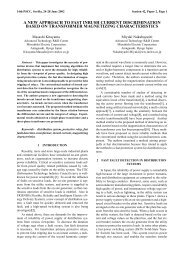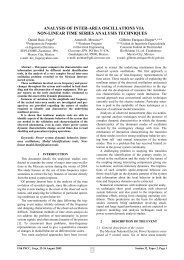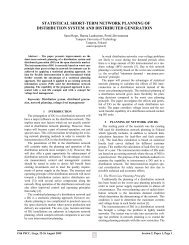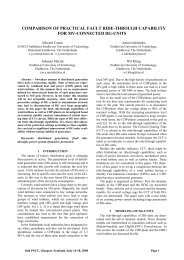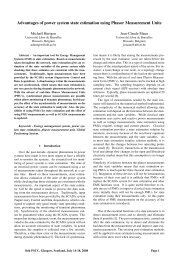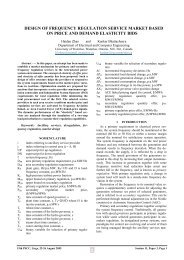advantages and limitations of the interline power flow ... - PSCC
advantages and limitations of the interline power flow ... - PSCC
advantages and limitations of the interline power flow ... - PSCC
You also want an ePaper? Increase the reach of your titles
YUMPU automatically turns print PDFs into web optimized ePapers that Google loves.
2 is in charge <strong>of</strong> fulfilling this dem<strong>and</strong> through <strong>the</strong><br />
Pse1 + Pse2<br />
= 0 constraint. Unlike VSC-1 (in <strong>the</strong> primary<br />
system) <strong>the</strong> operation <strong>of</strong> VSC-2 (secondary system) has<br />
its freedom degrees reduced; thus, its series voltage V C2<br />
can compensate only partially to its own line. This is<br />
because converter VSC-2 also has <strong>the</strong> task <strong>of</strong> regulating<br />
<strong>the</strong> dc-link voltage. So, <strong>the</strong> P se2 component <strong>of</strong> VSC-2 is<br />
predefined. This imposes a restriction to this line in that<br />
mainly <strong>the</strong> quadrature component <strong>of</strong> V C2 can be specified<br />
to control its <strong>power</strong> <strong>flow</strong>. Under this condition, <strong>the</strong><br />
primary system will have priority over <strong>the</strong> secondary<br />
system in achieving its set-point requirements.<br />
The equivalent sending <strong>and</strong> receiving-end sources in<br />
both AC systems are regarded as stiff. The condition for<br />
which <strong>the</strong> switch CB is closed (i.e. V 11 =V 21 ) also applies<br />
to <strong>the</strong> analysis presented in this section.<br />
System 1<br />
V 11<br />
V 12 V V P<br />
C1<br />
13<br />
V<br />
I 1 14<br />
14<br />
Z 11<br />
(P<br />
CB<br />
se1<br />
+P se2<br />
) = 0<br />
System 2<br />
V P<br />
C2<br />
I 2<br />
24<br />
Z 21<br />
Z 24<br />
V 21<br />
V 22<br />
V 23 V 24<br />
Figure 2: IPFC scheme used in <strong>the</strong> analysis<br />
It will also be assumed that both AC systems have<br />
identical line parameters. Likewise, it is assumed that<br />
each converter injects an ideal sinusoidal waveform<br />
with only its fundamental frequency [8], [9], [13]. The<br />
steady-state <strong>power</strong> balance <strong>of</strong> <strong>the</strong> n number <strong>of</strong> converters<br />
(same number <strong>of</strong> compensated lines) can be represented<br />
by (1):<br />
n<br />
∑<br />
i=<br />
1<br />
P 0<br />
(1)<br />
se _ i<br />
=<br />
As in our case n=2, we will have,<br />
P + = 0<br />
se1<br />
Pse2 (2)<br />
So for each line it can be written,<br />
P<br />
se1<br />
= VC1d<br />
I14d<br />
+ VC1qI14q<br />
(3)<br />
P = V I + V I<br />
(4)<br />
se2<br />
C2d<br />
24d<br />
C2q<br />
From Figure 2, <strong>the</strong> following system equations can<br />
be written:<br />
V12d<br />
= V14d<br />
−VC1<br />
d<br />
− X14I14d<br />
(5a)<br />
V12 q<br />
= V14q<br />
−VC1<br />
q<br />
+ X14I14q<br />
(5b)<br />
V22d<br />
= V24d<br />
−VC<br />
2d<br />
− X<br />
24I<br />
24d<br />
(6a)<br />
V22 q<br />
= V24q<br />
−VC<br />
2q<br />
+ X<br />
24I<br />
24q<br />
(6b)<br />
I14 d<br />
= k1( V11q<br />
−V14q<br />
+ VC1<br />
q<br />
)<br />
(7a)<br />
I14q<br />
= k1( −V11<br />
d<br />
+ V14d<br />
−VC1<br />
d<br />
)<br />
(7b)<br />
I<br />
24 d<br />
= k2<br />
( V21q<br />
−V24q<br />
+ VC<br />
2q<br />
)<br />
(8a)<br />
= k −V<br />
+ V V<br />
(8b)<br />
24q<br />
( )<br />
I<br />
24q<br />
2 21d<br />
24d<br />
−<br />
C 2d<br />
Z 14<br />
where k<br />
= 1<br />
( X + )<br />
,<br />
1<br />
11<br />
X<br />
14<br />
k<br />
= 1<br />
( X<br />
2<br />
21<br />
+ X<br />
24<br />
Equations (2) through (8) allow <strong>the</strong> main parameters<br />
<strong>of</strong> <strong>the</strong> elementary IPFC to be calculated (Figure 2).<br />
Unlike <strong>the</strong> GIPFC case addressed in [13], <strong>the</strong> unknown<br />
variable V C2d will be a function <strong>of</strong> V C1 (specified). Once<br />
computed <strong>the</strong> unknown variables (i.e. <strong>the</strong> d-q components<br />
<strong>of</strong> V 12 , V 22 , I 14 , I 24 <strong>and</strong> V C2d ), <strong>the</strong> <strong>power</strong> <strong>flow</strong> in <strong>the</strong><br />
receiving-end <strong>of</strong> Systems 1 <strong>and</strong> 2, with or without <strong>the</strong><br />
effect <strong>of</strong> <strong>the</strong> series voltage, can be calculated through<br />
(9).<br />
*<br />
S<br />
1<br />
= ( P1<br />
+ jQ1<br />
) = V14<br />
I<br />
(9a)<br />
14<br />
*<br />
S<br />
2<br />
= ( P2<br />
+ jQ<br />
2<br />
) = V24<br />
I<br />
(9b)<br />
24<br />
Note that System 1 will have two independently controlled<br />
variables (i.e. V C1 , θ C1 ). Conversely, System 2<br />
will only have one variable (V C2q ) to be independently<br />
controlled.<br />
3 RESULTS<br />
The results shown in Figures 3 <strong>and</strong> 4 were obtained<br />
using <strong>the</strong> ma<strong>the</strong>matical model developed in Section 2,<br />
in which θ C1 was varied from 0° through 360°. The area<br />
inside <strong>the</strong> circle corresponds to <strong>the</strong> ideal region controlled<br />
by VSC-1, which will be limited by <strong>the</strong> magnitude<br />
<strong>of</strong> V C1 (V max C1 ). The series reactive compensation in<br />
System 2 was set to be null (i.e. V C2q =0), thus, only <strong>the</strong><br />
V C2d component serves as a parameter through which<br />
active <strong>power</strong> is passed from Converter 2 to 1. The way<br />
how VSC-2 compensates to its own line, through its<br />
available reactive compensation, will be shown in Section<br />
3(c).<br />
Q (pu)<br />
0.2<br />
0<br />
-0.2<br />
-0.4<br />
-0.6<br />
P 1<br />
, Q 1<br />
(System 1)<br />
330°<br />
75°<br />
240° 60°<br />
255°<br />
θ C2= 0°<br />
30°<br />
300°<br />
120°<br />
150°<br />
210°<br />
P 2<br />
, Q 2<br />
(System 2)<br />
θ C1 =0°<br />
-0.8<br />
0.4 0.6 0.8 1 1.2 1.4 1.6<br />
P (pu)<br />
Figure 3: P-Q plane (receiving-end) showing <strong>the</strong> operative<br />
region <strong>of</strong> Systems 1 & 2 when V C1 =0.2 pu & V C2d =ƒ(V C1 )<br />
For this particular case, both AC systems were assumed<br />
to have similar transmission angles, i.e. δ 11_14 =<br />
δ 21_24 = -30°. Should <strong>the</strong>se angles be different, maintaining<br />
<strong>the</strong> same V C1 = 0.2 pu, <strong>the</strong> results obtained will be<br />
different. Such a case will also be analysed shortly after.<br />
Notice how <strong>the</strong> <strong>power</strong> <strong>flow</strong> in System 2 is forced to<br />
vary (P 2 ≅0.8pu → 1.2pu, Q 2 ≅-0.6pu → +0.1pu) on<br />
account <strong>of</strong> helping to control P 1 & Q 1 in System 1. For<br />
example, when V C1 =0.2 pu∠60°, with which System 1<br />
increases its active <strong>power</strong> to about P 1 ≅1.4 pu, System 2<br />
(straight line) will need to reduce its active <strong>power</strong> to<br />
)<br />
16th <strong>PSCC</strong>, Glasgow, Scotl<strong>and</strong>, July 14-18, 2008 Page 2



